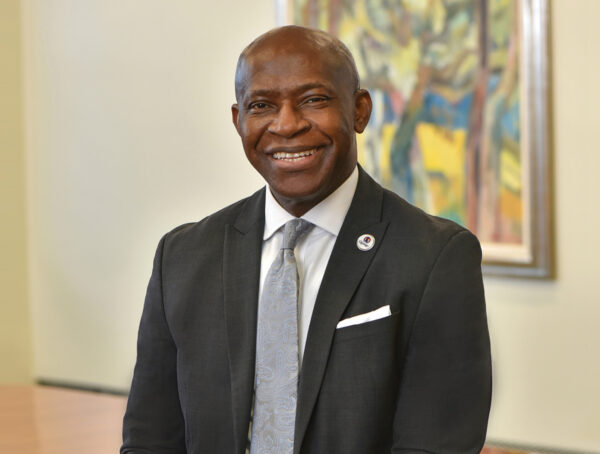On the seventh floor of an aging West 52nd Street building, on folding tables, corkboards and floors, they are creating.
On Craigslist and eBay, with items from prop shops and pickers, they are setting the scene.
On a laptop, at the fabric store, in discussions that float around this corner of the cavernous floor, they are building a character.
Meet the award-winning set decorator Debra Schutt ’77 and her team. This is the behind-the-scenes cast of the aspiring HBO series “The Corrections.” It’s a cast that won’t be talked about in the Hollywood rags or blogs, but their work is just as important to the success of the show.
Panning a rectangle of folding tables with laptops and coffee cups: Val is on the phone haggling over test tubes, Sammy is researching science projects as if they are on display in 1968 and Fanny is scouring the Internet for samples of erotic art.
Tina is managing the cash for the operation, Karen is mulling over set specs; and the production designer, David, is voting finds, samples and ideas up or down between conversations and emails with the show’s directors and producers.
And then there’s Debra, whose desk is nearly eclipsed by stacks of carpet, fabric, wallpaper and linoleum samples.
A poster board full of old family photos rests on the edge of her wobbly Ikea table. It’s a collection provided by Jonathan Franzen, the author of the book that inspired the show.
A rectangle of black foam core board on the wall behind Debra is labeled “Chip’s apartment” and has a sketch of a bright red chaise belonging to one of the main characters.
That bright red chaise is currently orange and sitting in a nearby room with a collection of other furnishings found on the Web or from middleman “pickers” who comb estate sales, storage lockers and the like for various objects.
“Lipstick red,” Debra says to herself while thumbing through some samples of upholstery fabric. She calls over to David for a second opinion.

Debra Schutt ’77 won an Emmy in 2011 for her work on the “Boardwalk Empire” pilot episode. Here, she recalls what went into the set decoration for these three scenes. “The first and last photos are scenes from the Lolly’s Casino. When I took the job I was very worried about where I was going to find the period tables. Luckily, I walked into an antiques shop in southern New Jersey called the Red Barn and there was the roulette table and it was from Atlantic City. “The middle photo is of Chalky White is on a set built at Steiner Studios in Brooklyn. The floor is painted marble and the fireplace, etc. is scenery.”
Later, Schutt will visit the fabric store in search of the specific color as well as a pattern that would fit with a couch in a suburban living room in the late 1990s, when the book takes place.
To create “The Corrections,” the set will need the right red, the most accurate fabric, the top props. Every conceivable detail down to how shiny the basement floor will be is mulled at this stage.
But, wait. Even in the age of high definition, who’s looking at this stuff?
“If you don’t notice, it means we did our job,” chimes Fanny.
Schutt slaps down a slab of 1960s basement-looking linoleum to gauge its authenticity.
“You don’t want people to notice,” she says in agreement without looking up. “You just want it to be right.”
For more than 30 years, Schutt has been doing it right as a set decorator, with a résumé that includes an Oscar nomination for “Revolutionary Road,” an Emmy win for the pilot of HBO’s “Boardwalk Empire” and memorable sets from films like “Fried Green Tomatoes” and “A Bronx Tale.”
MORE: See Debra’s resume
Schutt sees herself in the role of building a character.
All the furniture, flooring, drapery, wall coverings and appliances you see on the screen come from the minds, phone calls and clicks of the set decorator and her team. It takes months of long days to make a movie — or in this case, a pilot episode for a television show.
This pilot will determine whether HBO adds “The Corrections” to its stable of award-winning cinematic series.
At the heart of the plot for “The Corrections,” three 30-something siblings gather with their parents for one last Christmas in their childhood home. Reminiscing ensues.
That’s why Sammy needs to perfect a set of 1960s science projects and Schutt is inspecting a piece of wood to determine whether it will match the grain and thickness of the folding table a project like that would sit on in 1968.
Val needs those test tubes to finish off an amateur laboratory in the basement of the “Corrections” house and Fanny needs the racy artwork to cover the main character’s wall for a scene.

Debra Schutt ’77 was nominated for an Oscar in 2009 for her work on “Revolutionary Road” starring Kate Winslet and Leonardo DiCaprio. Here, she recalls what went into the set decoration in these scenes. “The director, Sam Mendes, wanted a pair of matching 5-foot sofas for the living room. We finally had them made new but when they arrived they were over-stuffed, so we had to have an upholsterer unstuff the pair the day before we shot the scene. “In the kitchen scene, there were five chairs in the set. At one point in the film, Leonardo breaks a chair and we had only one extra. The construction department made several extras out of balsa wood but luckily Leonardo did it in one take using the one extra real chair.”
“I love the picture that develops,” Debra says. “I love that I get the opportunity to create these visuals.
“There’s never a ‘no.’ You can do anything,” she says.
Her career in set curating has firm roots in Oswego, where she was a member of Pi Delta Chi and earned a degree in education. As an upperclassman, she was drawn to the technical side of theatre and found mentors in department staff like Ken Stone ’68 and Jon Vermilye ’66.
“Debra was one of our exceptional students,” Vermilye remembers. “A very dependable and resourceful prop master, if she was doing the show, you were assured that the job would get done and the quality would be excellent.”
Her experience in Waterman Theatre, and her friend Alice Maguire ’76, helped Schutt get her first professional gigs in theater. She made the transition to film in the mid-1980s as a set decorator, a title she’s maintained her entire career.
Like many jobs in the film industry, it’s a tough gig. There are the long hours and logistical challenges that come with each project — Debra routinely works 12-hour days and once had to scramble for office desk tchotchkes at 7 a.m. … 30 minutes before shooting.
Job security is determined by skill. The work comes project to project, typically through networking.
Even if “The Corrections” is picked up and becomes a series, Debra may not be its set decorator for the duration. The “Boardwalk Empire” pilot was a one-off job as well.
She continues to do movies — the much-buzzed-about Sacha Baron Cohen film “The Dictator” is one recent project.
Perhaps the greatest influence on her career, though, is her apple farm upbringing outside of Rochester. The long days at her family-owned and -operated Schutt’s Apple Mill gave her the frame of mind to make it on a film crew.
“I am a worker,” she says. “I will just sink my teeth in and work until I drop … I’m obsessed.”
Most of that work goes unnoticed, but that’s the point. If the fixtures, fabrics and furnishings are spot on, you’re watching the movie.
You might also like
More from Featured Content
Vision for the Future
VISION for the Future Peter O. Nwosu began his tenure as the 11th president of SUNY Oswego, building on the solid …
Envisioning the Potential in All Students
ENVISIONING the Potential in All Students Educator donates $2 million in recognition of his Oswego education, in support of future teachers Frank …
A Vision of Support
A VISION of Support Award-winning principal makes an impact on her school through her positivity and commitment When Nicole Knapp Ey ’02 …














